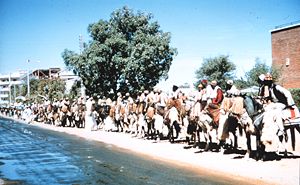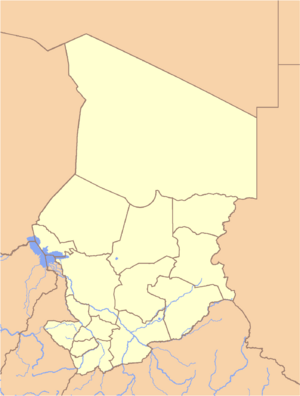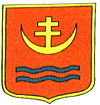N'Djamena
| N'Djamena نجامينا Nijāmīnā |
|||
 |
|||
|
|||
 N'Djamena
|
|||
| Coordinates: | |||
| Country | |||
|---|---|---|---|
| Region | Chari-Baguirmi | ||
| Department | |||
| Sub-Prefecture | N'Djamena | ||
| Population (2005) | |||
| - Total | 721,000 | ||
| Time zone | +1 (UTC) | ||
N'Djamena (pronounced /ənʤəˈmeɪnə/, Arabic نجامينا Nijāmīnā), population 721,000 (2005), is the capital city of Chad. It is also the largest city in the country. A port on the Chari River, near the confluence with the Logone River, it directly faces the Cameroonian town of Kousséri, to which the city is connected by a bridge. It is also a special statute region, divided in 10 arrondissements. It is a regional market for livestock, salt, dates, and grains. Meat processing is the chief industry.
Contents |
History
N'Djamena was founded as Fort-Lamy by French commander Émile Gentil on May 29 1900, and named after Amédée-François Lamy, an army officer who had been killed in the Battle of Kousséri a few days earlier. Its name was changed to N'Djamena (taken from the Arab name of a nearby village, Niǧāmīnā, meaning "place of rest") by the President François Tombalbaye on April 6, 1973, as part of his authenticité program of Africanization.
The city was partly destroyed during the Chadian Civil War, in 1979 and again in 1980. Many southern, Chadian inhabitants fled at the time, but the population has since regrown strongly. The city had only 9,976 inhabitants in 1937, but a decade later, in 1947, the population had almost doubled at 18,435. After independence in 1968 the population reached 126,483. In 1993 it surpassed half a million with 529,555.
On April 13, 2006, a rebel United Front for Democratic Change attack on the city was defeated.[1] (See Battle of N'Djamena (2006))
The city was once again attacked on February 2, 2008, by UFDD and RFC rebels. [2] (See Battle of N'Djamena (2008))
Demographics
The population growth is shown below:-
- 1937 : 9,976
- 1940 : 12,552
- 1947 : 18,375
- 1968 : 126,483
- 1993 : 529,555
- 2005 : 721,000
The city has a variety of religions, but with a clear Islamic predominance. The main ethnic groups are Ngambaye (16.41%), Chadian Arabs (11.08%), Hadjerai (9.15%), Daza (6.97%), Bilala (5.83%), Kanembu (5.80%), Maba (4.84%), Kanuri (4.39%), Gor (3.32%), Kuka (3.20%), Sara (2.24%), and Barma (2.10%).
Geography

N'Djamena is located at 12°6'47" N, 15°2'57" E.
While primarily an administrative center, the city includes the Nassara Strip commercial centre and residential areas such as Mbololo, Chagoua, Paris Congo and Moursal. The main commercial avenue of the city is the Avenue Charles de Gaulle.
Tourism
Attractions in the city include the Chad National Museum, a cathedral and several mosques. Views of sunset across the Chari River can also be spectacular.
Education
N'Djamena has a university, schools of administration and veterinary medicine, a number of secondary schools (including the long established Lycée Félix Éboué and Lycée technique commercial), and the American International School of N'Djamena.
Transport
The city is the eastern terminus of the Trans-Sahelian Highway, and is linked to East Africa by the Ndjamena-Djibouti Highway. The Tripoli-Cape Town Highway also passes through N'Djamena, making it a key Central African location in the Trans-African Highway network. Ndjamena is linked by road bridge to Kousseri in Cameroon.
N'Djamena International Airport (IATA code NDJ) is located on the outskirts of the city.
Historically, N'Djamena's main link to the exterior was by river boat up the Chari and Logone rivers but these now carry little trade. The city has no railway links.
Gallery
The following pictures are undated but were all probably taken in the 1960s.
Twinnings
Notes
- ↑ BBC: UN condemns rebel attack in Chad
- ↑ "Rebels clash with Chadian forces inside capital" (February 2, 2008).
External links
- Map of N'Djamena
- Best travel guide
- Photo 1 Photo 2 Photo 3
- http://earth-info.nga.mil/gns/html/cntry_files.html
|
||||||||
